This Earth Day, April 23, join Grace Farms for a day of family-friendly activities celebrating the wonder and benefit of trees.
Trees interwoven into our survival
Trees hold our memories of our human existence, measuring time and holding our experiences, from childhood to adulthood. They are interwoven into our lives, our survival, our flourishing.
Beyond their beauty and how they sculpt our lives and landscape, trees also provide an important and essential function of capturing carbon dioxide (CO2), a greenhouse gas linked to climate change or the earth’s warming. Trees pull carbon dioxide from the air through their leaves and release oxygen; the carbon is then stored and converted into carbohydrates to help the tree grow.
Trees are perhaps the best carbon capture technology in the world and are our best hope of slowing climate change, according to an article in The Guardian. “Planting billions of trees across the world is one of the biggest and cheapest ways of taking CO2 out of the atmosphere to tackle the climate crisis, according to scientists.” [1]
While Grace Farms was under construction, we took extra measures to not only protect the trees on site, but to plant additional trees, including native species. Grace Farms Foundation has planted nearly 700 trees, in addition to the 1,300 trees on-site before construction began. Grace Farms has more than 50 species of trees throughout our landscape. Our leadership intentionally made sure that the trees cut during the construction of the SANAA-design River building were repurposed for furniture. The trees were milled on-site and some of the SANAA-design furniture include our 18-foot-long red oak tables in the Commons, oak shelves in the Library, and the ash tables in the West Barn.
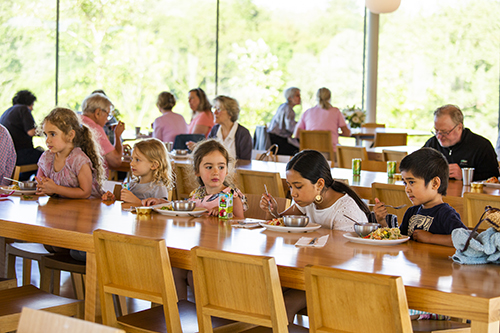
The Commons serve as a central community space to meet new and old friends over nutritious meals made on site. The fresh ingredients often come from our Community Garden. ©Vanessa Van Ryzin
We were also conscious of adding native trees and plants in the restoration of Grace Farms’ 80 acres. Native plants are those that grow in regions in which they evolved: they are an essential part of biodiversity and support native wildlife and our pollinators such as bees and birds. Doug Tallamy, entomologist, professor at the University of Delaware, and author of such best sellers such as Bringing Nature Home, says that native oak trees can support over 500 species of caterpillars, compared to the non-native ginkgo tree, which host only five species of caterpillars.[2]
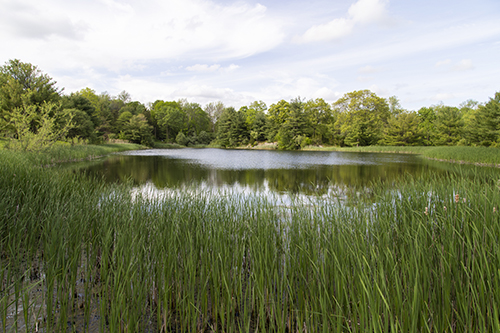
The restoration of the landscape into 10 biodiverse habitats has brought back over 100 species of birds and other wildlife to Grace Farms and the area. © Julien Jarry
Restoring Wildlife and Nature
In our Library, we have curated a selection of books across our initiatives of nature, arts, justice, community, faith, and Design for Freedom. You’ll find Tallamy’s Bringing Nature Home, an immersive investigation and observation on how to sustain biodiversity and wildlife with native plants. At Grace Farms, our restoration of 10 native habitats, including meadows, woodlands, and ponds, has brought back over 100 species of birds including North America’s smallest falcon, the American Kestrel. The kestrel was listed as threatened on Connecticut’s Endangered, Threatened, and Special Concern Species List in 2004, but it has since been down-listed to special concern in 2015.[3]
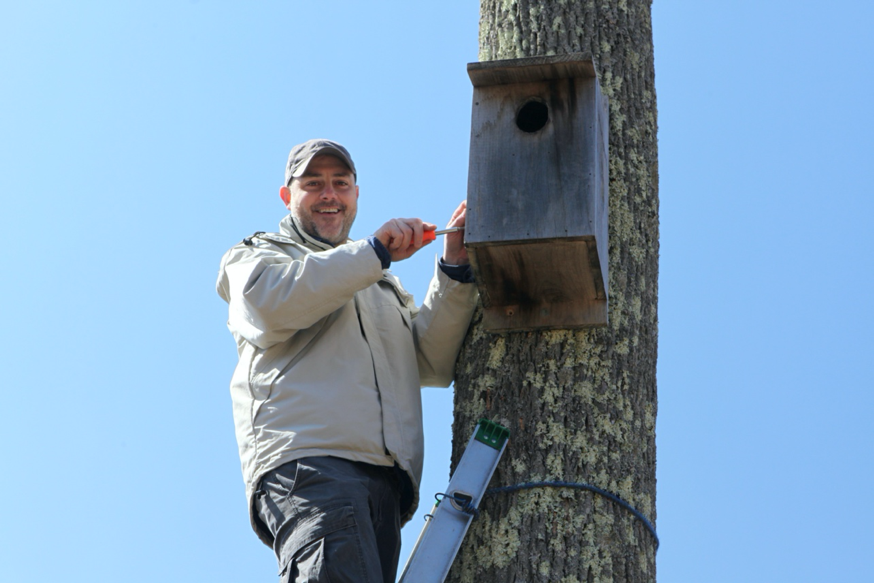
Mark Fowler, our Nature Initiative Director, installs Kestrel boxes on Grace Farms to provide nesting habitats for North America’s smallest falcon. © Grace Farms Foundation
During Earth Day, visitors will receive an oak seedling to take home and plant. Planting this tree is more than a celebratory mark of the 52nd Earth Day, but it’s also a practical action individuals can take to support biodiversity and wildlife. “A yard without oaks is a yard meeting only a fraction of its life-support potential,” said Tallamy in The New York Times.[4] Oaks support more life-forms than any other North American tree genus, supporting thousands of species of insects and animals.[5]
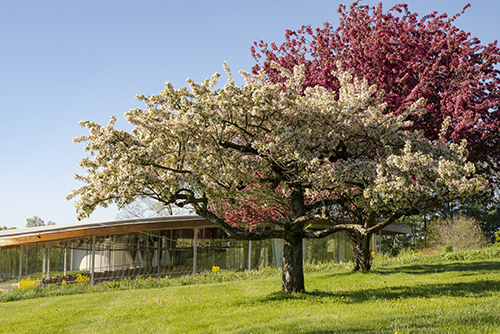
Each season is beautiful and unique at Grace Farms. Flowering trees in the spring offer pollinators a food supply after a long winter. © Julien Jarry
Flowering spring trees also support life, particularly during a time when food sources scares when pollinators emerge. Laura Green from Yale’s School of Forestry and Environment, will teach participants how to identify flowering trees on Grace Farms. There are flowering trees throughout the landscape and visitors will get an opportunity to learn about each trees’ unique characteristics, environments where they thrive, and their benefit to pollinators and wildlife.
Discover the power of forest bathing
Over the years, we found a secondary benefit to all of us, besides mitigating climate change. Forest have incredible healing powers in terms of our physical and mental well-being. During Earth Day, participants will have a unique opportunity to reconnect with nature on a tour with a certified forest bathing guide. In the 1980s, the Japanese Ministry of Agriculture, Forestry, and Fisheries created the term shinrin-yoku, which translates to “forest bathing” or “absorbing the forest atmosphere.” [6]
Since then, forest bathing has emerged from the fringes and has become more mainstream. This NPR story takes us on a forest walk with a certified forest bathing guide. “The aim of forest bathing, [Melanie] Choukas-Bradley explained, is to slow down and become immersed in the natural environment. She helped us tune in to the smells, textures, tastes and sights of the forest.”
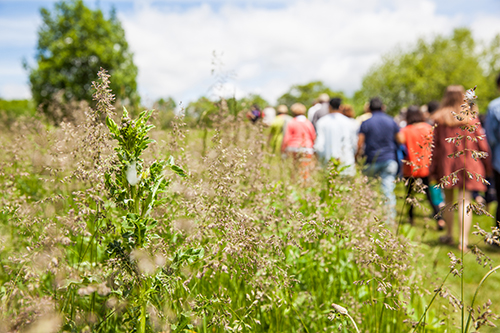
The 10 biodiverse habitats, including woodlands, provide visitors an opportunity to pause and learn about the benefits of nature. Our more than 30 weeks of free nature programing allows for visitors to learn more and find ways they can help preserve and project nature. ©Vanessa Van Ryzin
The NPR story goes onto explain that on a very practical level, forest walkers who ranged in age from 36 to 77 saw on average of a seven-point reduction in their systolic blood pressure after four hours in the forest,[7] said Amos Clifford, a former wilderness guide and founder of the Association of Nature & Forest Therapy, the organization that certifies the guides.
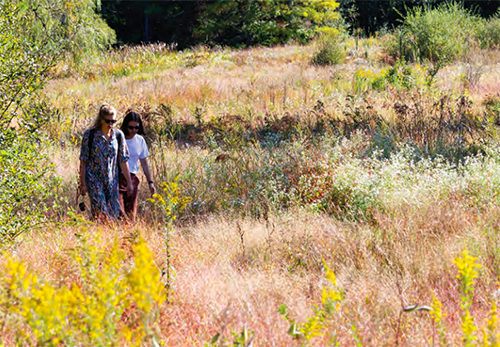
Whether a guided tour on discovering nature and habitats at Grace Farms with a friend or on your own, the benefits of walking in nature are still the same. © Dean Kaufman
Unfortunately, not everyone has access immediate access to nature and acres of natural landscape to explore. Grace Farms, open the public (see our hours), provides a welcoming and peaceful space that invites people of all ages and backgrounds to discover Grace Farms through our public programming or through self exploration. Grace Farms was intentionally designed to create a continuous connection between nature and architecture, breaking down boundaries between people, architecture, and nature. The River building, designed by Pritzker Prize-winning architects Kazuyo Sejima and Ryue Nishizawa, is embedded into acres of natural habitats. Regardless of where people are in the River building, they are always aware of the surrounding landscape and wildlife, including many species of birds, pollininators, and our resident snapping turtle.
“Surrounded by peace and welcomed into this awe-inspiring landscape that has been infused by constant interplay of ideas, people are likely to experience a new sense of perspective and purpose.” – Sharon Prince, CEO and Founder, Grace Farms Foundation.
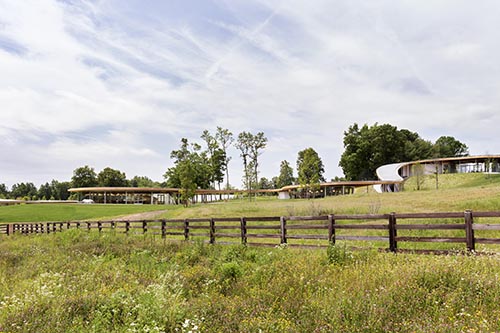
The award-winning River building is embedded in the landscape and surrounded by 77 acres of restored and natural landscape, including meadows. © Dean Kaufman
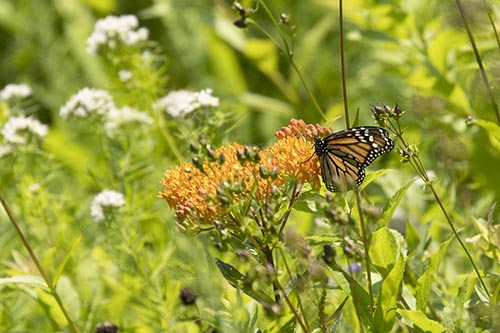
Thousands of native plants have been installed over the years at Grace Farms, creating a thriving environment for pollinators such as birds, bees, and butterflies. © Julien Jarry
The intent is to pause
The intent is to pause. Another intent is to invite the community and a broad selection of cross-sector leaders, including our initiative experts, to address the most pressing humanitarian issues of our time, such as forced labor in the built environment. As we explore the trees and forest this Earth Day, we’re mindful of this purposeful link to our work.
The launch of Design for Freedom in October 2020, a new initiative and moment joined by more than 80 leaders from the ecosystem of the build environment, aims to remove forced labor from the building materials supply chain. As we examined the building materials most at-risk of using forced labor in our ground-breaking Design for Freedom report, we addressed how “timber is one of the most widely used construction materials in the world and is ranked as the fifth largest product (by value) at risk of forced labor imported into the U.S.” [8]

Sharon Prince, CEO and Founder of Grace Farms Foundation, during a Design for Freedom Working Group meeting in New York City. © Niv Rozenberg
We are working with leaders in the built environment, as well as leading educational institutions and policy makers, to make institutional changes and to activate Design for Freedom Pilot projects. (Learn more about our pilot projects.) As Grace Farms uses this hopeful space to address this and other humanitarian and cultural issues around the world, our trees are part of our hopeful space. They provide space for artists and poets to dream and create, space for architects and designers to reimagine our relationships between nature, architecture and people, and space for all of us to restore and reconnect with our purpose in life.
The Architecture of Trees
On display in our Library is The Architecture of Trees. Written by Italian designers Cesare Leonardi and Franca Stagi, the Princeton Press describes the book as “a legendary and unsurpassed botanical masterwork” that features more than “550 exquisite quill-pen illustrations of 212 tree species.” In their work, “Ms. Stagi meditates on how “nature experiments in infinite ways” within the confines of trees that “grab on to the planet” and thrive only where it suits them.”[9]
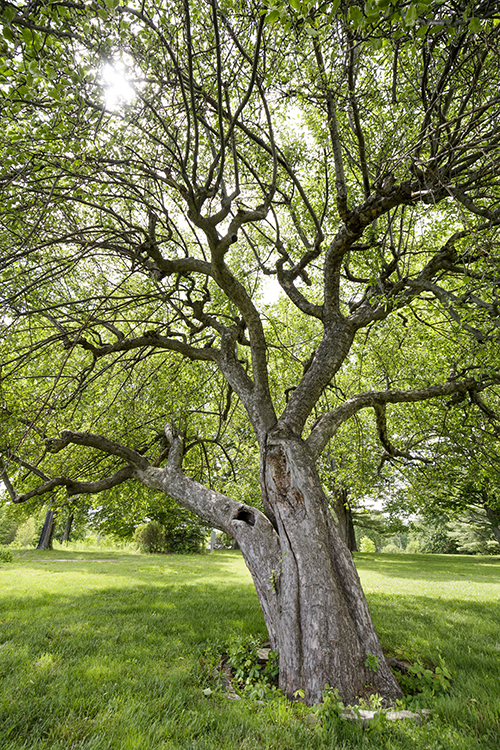
We care for our trees at Grace Farms, whether old or young. We take care of over 2,000 trees; not only do they provide beauty they also take care of all of us. © Julien Jarry
“We forget that they breathe every day, leaf by leaf. We forget about their unique and extraordinary ability to draw food and energy from light. We overlook their constant and vital contribution to the life of the planet as they produce oxygen and supply it to all other creatures … Knowing trees means rediscovering this.” – Cesare Leonardi and Franca Stagi
As we celebrate Earth Day at Grace Farms and around the world, perhaps we can pause to meditate on how nature and trees impact our lives in infinite way and how essential they are to our shared humanity and a flourishing life.
[1] “Tree planting ‘has mind-blowing potential’ to tackle climate crisis,” The Guardian, 2019.
[2] Why Native Plants Matter, Audubon.
[3] “American Kestrel,” Department of Energy and Environmental Protection. Rev. 12, 2019.
[4] Roach, Margaret. “Why You Should Plant Oaks,” The New York Times. March 31, 2021.
[5] Ibid.
[6] Fitzgerald, Sunny. “The secret to mindful travel? A walk in the woods,” National Geographic. October 18, 2019.
[7] Aubrey, Allison. “Forest Bathing: A Retreat To Nature Can Boost Immunity And Mood,” NPR. July 17, 2017
[8] Global Slavery Index 2018, Findings by Country – United States, Minderoo Foundation. 2018.
[9] Kahn, M. Eve. “Four Design Books to Spruce Up Your Home,” The New York Times. May 6, 2019.

